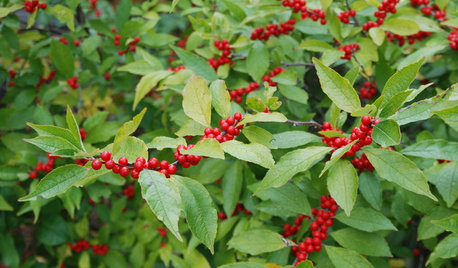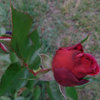'Oakington Ruby', a "dwarf" China.
User
last year
Featured Answer
Sort by:Oldest
Comments (6)
User
last yearRelated Discussions
Vintage One-of-a-Kind Sale
Comments (6)Just keeping everyone updated - Vintage sent out the roses that are still left after the first rush and that's posted below. Among these, I see an additional recommendation for The Prince's Trust that I got from Vintage a few years ago, and it's a red climber that very enthusiastically wants to grow. It was probably the biggest band plant I've ever seen at nearly 4 feet long, and it put on another 5-6 feet in its first year. It's a very healthy happy climber in my zone 5. Cynthia Remaining list as of March 6: Ch "Ferndale Red China" 1 ChCl Setina 1 E Jeannie Deans 1 Fl Centenaire de Lourdes 1 Fl Europeana 1 Fl Fire and Ice 14 Fl Fred Loads 1 Fl Holstein 1 Fl Impatient VID 1 Fl Jazz Fest VID 1 0 Fl Kirsten Poulsen 3 Fl Lili Marlène 1 Fl Lipstick 1 Fl Orange Garnet VID 2 Fl Playboy 1 Fl Showbiz VID 2 FlCl Heidelberg 9 1 HB "California Malton" 1 HM Heinrich Conrad Soth 1 HM Verdi 2 HP Dr. Masaryk 4* HP François Arago 5* HP Marguerite Guillard (Loubert) 8* HP Mme. de Staël 15* HP Paul's Single White Perpetual 3* HP Rose de Bouffarik 2* HP Silver Queen 1* HP "Souvenir de Mme. Berthier" 5* HT Blithe Spirit 1 HT Broadway 1 HT Chivalry 3 HT Die Welt 2 HT Ellen Willmott 1 HT Frances Ashton 1 HT Harry Wheatcroft 1 HT Kalahari 3 HT Love VID 1 HT Macho Man 1 HT Maria Callas VID 1 HT Movie Star 1 HT Peach Beauty VID 1 HT Slava 2 HT Tropicana VID 1 HTCl Amy Johnson 1 HTCl General MacArthur, Climbing 1 HTCl Queen Elizabeth, Climbing VID 8 HTCl Reine Olga de Wurtemburg 9 LCl Casa Blanca 2 LCl Coral Dawn 1 LCl Crimson Cascade 1 LCl Doubloons VID 1 LCl Dr. Covell's Carrotrooted Understock 2 LCl Eden 6 LCl Étendard 1 0 LCl Gold Rush VID 2 LCl Golden Threshold 3 LCl High Noon 1 LCl JACclam (aka America™) 1 LCl Joseph's Coat VI 1 1 LCl Lawrence Johnston 4 LCl Leverkusen 3 LCl Olive 5 LCl Pelé 4 LCl Rosendorf Schmitshausen 1 LCl Salita 8 LCl Sympathie 2 LCl Tempo VID 1 LCl The Prince's Trust 1 LCl White Cocade 2 LCl William Baffin 1 2 M "Joséphine de Beauharnais" 15* Min Magic Carrousel VID 1 Min Oakington Ruby 1 N "Lingo Musk" 1 N Narrow Water 1 Pol Ave Maria 5* Pol Mme. Taft 2 4* Pol Petite Marcelle 24* Pol Rösel Dach 16* PolCl Rose de Montplaisir 4* R America 3 R Baby Shower 4 R Chevy Chase 5 R Cooper's Burmese 4 R Dr. Huey VID 4 R Harry Maasz 1 R "Mystery Muse" 3 R Not Cherub 4 R Purity 7 1 R Ramona 3 R Roserie 2 R Wartburg 1 R Windermere 3 S Ferdy 10 S Hamburger Phoenix 7 S Illusion 1 S Romanze 1 S Rosy Cushion 4 3 S Salmon Wings 7* S Sandrine David 2* S Yellow Butterfly 3 S/AUS John Clare 6 S/Aus Red Coat 1 *Starred items are French Imports priced at $30 each...See MoreSpring 2015 garden shots
Comments (62)Also on the deck, coming up by the stairs, is 'Reine des Violettes' which continues "blueing" after opening its blooms. Thanks to "tweaking", I captured the color as it is right now on these three-day-old blooms. 'Tamora' opened her first bloom, and a few others are almost opened. But at the moment, she's a bit lost in this. The deep pink blooms belong to another long, arching cane on 'Mme de Sevigne' coming from the right of this pic. The white in the lower right corner is pegged 'Botzaris'. The white against the fence is 'Bubble Bath'. And the purple in the center of the right edge is 'Purple Skyliner. Clematis blooming on the fence, from left to right, are 'Red Star', 'Lasurstern', and 'Blue Light'. Same area as above, but closer to the front. You can see 'Botzaris' pegged in the center, with Dianthus 'Bath's Pink' to its right, and 'Mme Dore' to the right of that, with 'Monsieur Boncenne' behind her. See all the deep pink Bourbon blooms in the upper center of the pic? That's all 'Mme de Sevigne', arching up and over the others. She put out a few fat, tall, arching canes which I held in place with tree branches. This rose is really more of a climber, growing like 'Mme Isaac Pereire', perhaps even more so. But its canes seem rather self-supporting -- until the buds form, which is when I had to prop them up a bit. Near the short path in the bed to the garage window is 'Clotilde Soupert' still slowly opening its blooms. To its right is 'The Prince', which looks like it's going to have a rather stingy first-flush this year, just as it did last year. But then it blooms more often during Summer and into Autumn. Odd, right? When a rose has as many petals as 'Clotilde Soupert' has, it takes a while for them to open. I kept saying "any day now" for over a week. Notice there's no balling -- while we had some rather cool days this Spring, it's been unusually dry. CS balls for me only when cool and wet -- cool and dry, or warm and wet, I don't see balling. And I'll finish up with areas that still need further attention -- and roses. This area gets full-sun during the hottest parts of the day, so I'm going to think about Chinas and Teas which may work in a narrow bed against the neighbors' house. Here's 'Perle d'Or' which is still rather tiny, but came as one rooted twig two years ago. Despite my tweaking, I can't capture its apricot tints. To be continued.... :-) ~Christopher...See MoreHave / Want
Comments (4)Hello, I have seeds that I would like to trade, below is a list of seeds I have to trade and a list of what I want. Musquee de Provence Pumpkin, and regular pumpkin ,Sprout mix, Swiss chard, Watercress, Dates, Grapefruit seeds and organic Grapefruit, Collards, Parsnip, Honeydews, rhubarb, Florida Ferns, Beautiful Red Crepe Myrtle, Tall Boneset, Evening Primrose, Borage, Dwarf Sungold Sunflower (teddy bear) , Giant White Moonflower from ( burpee seeds ), Mina Lobata ( spanish flag ), Formosan Lily, Anise-Hyssopus, Tickseed, Cactus( Sedum pachyphyllum), Mixed 4 o'clocks,. 3 Ranunculus holland grown, 5 packs of Garnet Red Amaranth, ..... If there on the list they are still available, I delete thyem as they go . I am looking for all kinds of Tomatoes, Peppers, Cucumbers, Eggplant, Zuccini, Summer Squash, Radish, Beets, Onions, Scallions, Carrotts, Chinese cabbage ,and regular Cabbage, Broccoli, Cauliflower, Spinach, Green Beans, Basil, Oregano, Parsley, Celery, Mint, Garlic, Dill....... let me know what you have . Please contact me for exchange ,thanks...See MoreTrading Info
Comments (0)Items I have for trade I have the following rather large plants in my yard. If someone could talk me through how to get samples, I should be able to do this. azalea (pink) Bamboo camellia (deep rose) crepe myrtle (I think this one blooms a light pink, but I am unsure) Fantasia Japonica Fig tree hydrangea Monkey grass Also, I just germinated a few Majorcan Date seeds. Seeds I can share (I purchased these seeds): alfalfa (VNS) Amaranth, red Garnet Angelica Anise Anise hyssop Arugula Asparagus -Mary Washington Basil – Italian, Thai Bean – Blue Lake (BUSH), FAVA – Broad Windor, Golden Wax, King of the Garden Beets – hioggia, cylindra, early wonder, ruby queen, bull's Blood, Detroit dark red Bergamot Borage Broccoli - Waltham 29, green sprouting Brussels sprouts - Long Island Bush beans - blue lake, contender Butternut squash - winter squash Cabbage – Copenhagen market, golden acre, pak choy, Chinese cabbage, red rock mammoth California giant heirloom zinnia carraway Carrots-Danvers, scarlet Nantes, red cored chantenay, shin kuroda, royal chantenay Catnip Cauliflower - Snowball Cayenne Pepper Celery – Tall Utah Chamomile Roman and German Cherry Tomato - Large Red Cherry Chervil - Curled Collards – Georgia Southern, vates Coriander - Cilantro Corn - golden Bantham, Yellow Dent Cornsalad - Dutch Cosmos crazy mix Cress - Curled Cucumber - Marketmore, pickling Boston, Straight Eight, poinsett Culver's root Cumin Dark opal basil Dill - Mammoth Echinacea Eggplant - Black Beauty, long purple Fennel - Florence Garlic chives Gerbera Daisy Goji berry Green beans - provider Heal all Hummingbird & Butterfly Garden Mix (perennial and annuals) Hyssop Kale - blue curled scotch, dwarf Siberian, dwarf blue curled, red Russian Kohlrabi – purple Vienna, white vienna Lavender Lemon balm Lettuce - black seeded Simpson, iceberg, ruby red, bronze mignonette, butter crunch, oak leaf, prizehead, red romaine Lima beans - Henderson Mad dog skullcap Marigold Marjoram Melon - Hales Best Jumbo, Hearts of gold, honey dew green flesh, honey rock, banana, rocky ford Mexican mint Milk thistle Mint Mixed Daisies Mustard – florida broadleaf, southern giant curled, old fashioned okra - spineless Clemson, emerald, perkin’s long pod, red burgundy Onion - Red Burgundy, yellow Utah sweet, evergreen bunching, white sweet Spanish, yellow sweet spanish Onion chives Oregano Oregano Greek Parsley – moss curle Parsnip - Harris model, hollow crown Peas - green arrow, little marvel, sugar snap Pepper – banana, alifornia wonder, cubanelle, early jalapeno, Hungarian hot was, cayenne, long red thin, serrano Pink chrysanthemum Pinto beans - shell Pumpkin - small sugar, mammoth gold Radish - cherry belle, French breakfast, white icicle, champion, china rose, comet Rosemary Rutabaga – American purple top Sage Savory - summer Scallions - green bunching Snap peas - sugar peas Spaghetti squash - winter squash Spinach - blooms dale, giant noble Squash – early straight neck, table queen acorn, cocozelle, table queen, Waltham butternut, zucchini dark green, zucchini golden, blue hubbard, early white bush, table king bush, vegetable spaghetti Stevia Swiss chard - ford hook, large white ribbed, ruby red Tarragon Thimbelina Fragrant Double Thyme - winter Thyme, orange Tomato - Beefsteak, Roma, Rutgers, ACE 55, San Marzano, Floradde, golden jubilee, homestead 24, red cherry lg, Rutgers, azoychka, big rainbow, brandywine red, Cherokee purple, chocolate stripes, costoluto Genovese, marion, marglobe improved, purple calabash, striped suffer, tigerella, yellow pear Turnip - seven top, white globe purple, purple top, shogoin, white egg Watermelon - Crimson sweet, sugar baby, black diamond, Charleston grey, congo, tendersweet orange Witch hazel Yarrow, white Zucchini - black Beauty WHAT I Want If it blooms, smells good, looks interesting, has different textures, can be used as a house plant or a container plant outdoors, or can go in the garden (veggies or fruit) then I am interested. I am listing a ton of ideas, but this is in no way extensive. If you have something that isn't on my list, let me know because I am probably interested. (Seeds, bulbs, cuttings, plants) Abutilon Adenium African mask plant African violets (My grandmother always collected these) Ageratum Aloe Vera Alternanthera Aluminum plant Angelonia Anthurium Arabian jasmine Asiatic lily Asparagus fern Asters Astilbe Autumn joy Baby's breath Bacopa Bamboo Palm Begonias Birds nest fern Black-eye-Susan Blanket flower Bleeding heart Bolivian Jew Boston fern Brachycome Brandywine (viburnum nudum) Brazillian fireworks Bridal wreath spiraea Browallia Butterfly bush Caladium Calatheas Calibrachoa Cannas Celosia Chenile Chinese evergreen (Aglaonemo) Chrysanthemum Cipher Citrus Coleus Copper leaf Corabells Cordyline Corsage orchid Creeping wire vine Croton Crown of thorns Daffodil Dalmatian bellflower Daphne's Odara Day lily Delphinium Diachondra silver falls Diacia Dianthus Diascia Dracaena Dragon wing begonia Dusty Miller Dwarfs plume grass ERysimum Eucalyptus European cornel Evovulus Fiber Optic Grass Fiddle leaf plant Fire witch dianthus Forget-me-not Foxglove Fuchsia Gazznia Geraniums Gerbera Daisies Gomphrena Graptophyllum Guara Pink Fountain Harlequin glory bower Helichrysum Helichrysum Icicles Helichrysum licorice vine Heliotrope He'll ours peppermint ice Hibiscus – (My Mother always collected these) Honey suckle Hypoestes Impatients Indian blood peach tree (This is what my Grandmother called this tree) Iresine Iris Ivy geranium Ivy variegated and Green Jacaranda tree Joseph's Coat Kaleidoscope Amelia Knock out roses Lamium beacon silver Lantana Lemon grass Lobelia Lotus Lysimachis Magilla Perilla Maidenhair Fern Melampodium Mock orange Money tree Monstera deliciosa Moss rose Muscadine Bush Nemesia Nerve plant New Guinea Impatients Newesia Nicaoataians Nierembergia Nirembergia Oleander Orange jasmine Ormental grasses Osteserman Oxalis Pansy Pansy Orchids Papyrus Passion flower / may pop Peace lily Pelargonium Pentas Peony Peruvian lily Petit blue Petunia Phlox Plectranthus Pleomele (Song of India) Plumbago Poimsettia Portulacca Potatoes (red, gold, yellow) Prayer plant Purple fountain grass Purple Heart Rainbow chard Reblooming lilac Red Aglaoneme Red Japanese Oak Rex begonias Rubella (skimmia japonica) Salvia San coleus Scaevola Scheduler a Silver vase plant Solanum Spider plant Strawberries Streptocarpus String of pearls Sun coleus Super cascade petunia Sweet bay tree Sweet potato vine Tahitian Bridal Veil Tea rose begonia Thyme, doon valley Ti Plant Tomatillos Torenia Trailing petunia Trailing vinca Tulips Umbrella plank Variegated basket grass Verbena Vina vine Vinca minor Wandering Jew Wave Torenia Zinnia Anything Tropical...See MoreHU-284226487
last yearUser
last year
Related Stories

GARDENING GUIDES12 Gorgeous Flowers and Shrubs for Winter Gardens
These pick-me-up plants brighten gray days and add color, structure and fragrance when everything else is dormant
Full Story
FRUIT TREESHow to Grow Your Own Persimmons
Sturdy and easy to care for, these trees offer bright fruit through winter — and keeping them in bounds is no sweat
Full Story







Alana8aSC